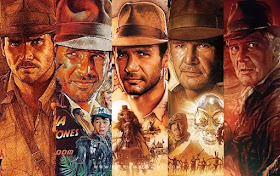I finally got around to watching Indiana Jones and the Dial of Destiny this past weekend. I liked it more than I expected, and some quibbles aside, I think it's a nice ending to the series.
It got me to thinking about the Indiana Jones film series in general, and I realized something that I hadn't before. An internet search tells me I'm not the first to have the basic idea--maybe even Lucas has said things that alluded to it, but no one has really looked at the implications over the whole series.
The Indiana Jones films can be viewed as a series of unsuccessful attempts to bring the protagonist to redemption and the end of his arc.
The Arc and the Ark
The Indiana Jones of Raiders of the Lost Ark is not a good guy. This has been obscured a bit by him becoming a franchise hero and a pop cultural figure, but it's clear in the first film. I don't just mean with in regard to the colonialist elements of his work and adventures when viewed through a 2024 lens, I mean textually. Indiana Jones is a thief, as the opening sequence shows us. Maybe he steals artifacts to put them in museums instead of for the black market, but it's still theft and he's paid for it. The major difference between him and Belloq is that Belloq chooses to work with the Nazis and that's a step too far for Indy.
Let's not forgot he also enters a relationship with his mentor's teenage daughter when he's in his mid-twenties, then runs off and abandons her.
All of this was intentional because one of the inspirations for the character of Indiana Jones and his appearance was the roguish Harry Steele (Charlton Heston) in Secret of the Incas (1954). At the end of that film, Steele has at least partially been reformed by the love of a good woman--and conflict with antagonists more villainous than himself.
It's a lot like what happens to Indy in Raiders. He reconnects and rekindles his relationship with Marion, and he becomes motivated to stop the power of the Ark from falling into Nazi hands. In the end, the cynic and skeptic comes to respect the Ark's power and survives the apocalyptic judgement on the evildoers it unleashes. He and Marion head off together in a happy ending.
Back to the Temple of Doom
Really, Raiders seems like it's meant to be the ending to Indy's story. He gets his redemption and heads off into the sunset. The first sequel, Temple of Doom, respects this arc by being a prequel. It's a story of the old Indy before he met the Ark. Sure, he does return the stones to the village they belong to rather than steal them, but he was always a rogue with a heart of gold, so the occasional lapse into heroic action is allowable.
The only problem with ToD from this perspective, I think, is that Indy encounters the supernatural, which the Indy of Raiders seems skeptical of until he sees it in action. One would think he would be more of a believer if he had encountered such things before. I think this is the first indication of a formula beginning to develop.
Grails, Skulls, and Dials
The subsequent films are all sequels to Raiders, and more then ToD, tend to follow its formula. In order to do this, they have to backtrack a bit, not necessarily unrealistically, on Indy's redemption arc. Also, he's a bit less in need of that redemption because he's portrayed somewhat more heroically in these films. Nevertheless, we get the arc repeated with Indy reconciling with his father, reconciling with his son, his goddaughter, and again reconciling with Marion (in two films!). As with Raiders, a supernatural force and a battle with evil to possess it (and a realization that it can't be possessed) is the vehicle for this reconciliation. The needs of the franchise demand he never fully learns his lesson and gets his happy ending.
Last Crusade adds another interesting element that highlights this arc in case anyone was missing it. We have a flashback where the young Indiana Jones is in conflict with a treasure-hunter who is almost a double of his adult self over the Cross of Coronado. In the context of the more heroic version of Indy that developed since Raiders, Indy's "it belongs in a museum!" focus is contrasted with the venal treasure hunter. But curiously, the young Indy explicitly models his adult style on this hunter. The film remembers what the franchise is trying to forget. Adult Indiana was pretty much indistinguishable with the treasure hunter until he encounters the Ark.




Hmm. An archeologist digs up items from the past. They go in a museum, or sometimes into private collections. It's a job, they need to make a living, so they get paid. Most of the time it's not glamorous. But these are movies, so they are adventures. If an archeologist's life makes someone uncomfortable, I'd think they'd avoid the movies.
ReplyDeleteArcheologists dig up items from the past it's true, but there is permitting and the like, and legitimate concerns about who does permitting. A person who digs something up for their private collection without appropriate permission is, in fact, a thief.
ReplyDelete